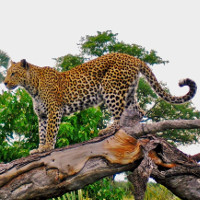 |
Indian leopard |
|
He is a wild animal |
Origin |
India, Nepal and Bangladesh | |
Translation |
Francis Vandersteen |
| The possession of this animal is not authorized Royal Decree establishing the list of mammals not kept for production purposes that may be kept (M.B. 24.08.2009) |
| The Indian leopard (Panthera pardus fusca) is a subspecies of leopard. It can be distinguished from the African leopard by the color of its coat and its smaller size. Melanistic individuals (black leopards) are notably more numerous. Its prey are mainly chitals in the Indian peninsula and muntjacs in Nepal. The Indian leopard cohabits with the tiger: it has been observed that when the tiger is present, leopards are fewer in number and smaller in size, as leopards prey on smaller game so as not to compete with the larger cat. The Indian leopard is one of the five big cats found in India, along with the Asiatic lion, Bengal tiger, snow leopard and clouded leopard. An adult male measures between 1.20 and 1.40 m in length, weighing between 50 and 77 kg. Females are smaller, measuring 1.04 to 1.17 m in length and weighing 29 to 34 kg. Balaji, a leopard now captive at the Sri Venkateswara Zoological Park in India, holds the title of the world's largest leopard, having weighed 108 kg when captured in 1996 and now weighs 139 kg. The animal had been roaming the park illegally, attracted by the easy prey of the zoo's herbivores. The Indian leopard's coat is darker than that of the African panther, with dark circular spots slightly tinged with pale red. There are also black panthers (more numerous than the other subspecies, which appear to be almost solid black, but in reality their spots are visible in bright sunlight. They do belong to the same subspecies, but just have a different coloration. The Indian leopard lives on the Indian subcontinent from west of the Indus to north of the Himalayas. In the east, the lower reaches of the Brahmaputra river and the Ganges delta form natural barriers between its range and that of the Indochinese leopard. This panther is distributed throughout India, Nepal, Bhutan, Bangladesh and parts of Pakistan. In the Himalayas, it is sympatric with the snow leopard up to 5200 m altitude. Its habitat is tropical forest, dry deciduous forest, temperate forest and coniferous forest. It is, however, absent from the mangroves of the Sundarbans. Like its African cousin, the Indian leopard is a predator with a mainly carnivorous diet. Its prey are mainly medium-sized cervids such as axis deer, hog deer, muntjacs, chinkaras, tetracera antelopes, cervicapres antelopes, young sambars, barasinghas and nilgauts and, more rarely, young gaurs. It will also prey on langurs and other primates, other small predators, wild boar and reptiles such as pythons and small crocodiles. More rarely, the Indian leopard may attack other predators such as young bears, tiger cubs or even a solitary dhole. Unlike the African panther, the Indian leopard doesn't climb into trees to eat its prey, the forest cover of its habitat perhaps offering better protection from greedy eyes as may be the case in Africa. Furthermore, while the diversity of competing predators is similar to that found in Africa, concentrations are lower, as the main predators in India, with the exception of dholes, are solitary. The habits of the Indian leopard are similar to those of the African leopard. It is a solitary animal, and adults meet only to mate. The males' territories overlap those of several females. This highly adaptable animal can be found in all of India's ecosystems, from arid to mountainous to dense forest, making it the most widespread of the fawns. Its life expectancy is between 12 and 17 years. The Indian leopard cohabits with the tiger. However, when the tiger is present, the leopards are fewer in number and smaller in size. In such cases, the panther will go for smaller game to avoid competition with the bigger cat. |






 English (United Kingdom)
English (United Kingdom)